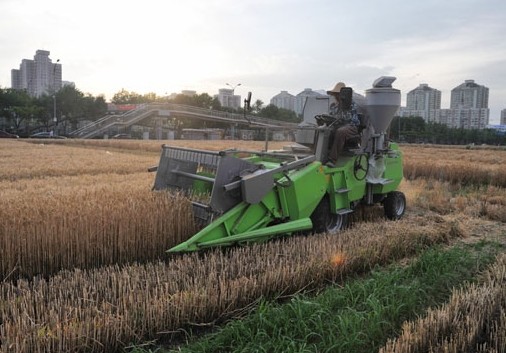

The price of domestic wheat is now around 2,610 yuan ($425) a metric ton, while wheat of a similar quality from the US is priced at 2,200 yuan a metric ton in the Chinese market after customs clearance, data from China's Zhengzhou Commodity Exchange shows. CHINA DAILY
China must take resolute measures to restrict large-scale grain and cotton imports and crack down on smuggling activities to ease the pressure on the country's record-high grain inventory rate, the head of China's agricultural policy bank said.
Zheng Hui, president of the Agricultural Development Bank of China and a member of the Chinese People's Political Consultative Conference National Committee, said China's high growth rate of grain yield and minimum grain purchase price mechanism have pushed the government to seek more space to store domestic grain and cotton.
The inventory amount overseen and supported by ADBC's loans for grain, cotton and edible oil-processing enterprises rose by 35 million metric tons from 2000, the last peak year for excessive grain reserves, to this year. It holds 88 percent of China's total inventory for agricultural products.
China introduced floor prices for farm products in 2006 to protect farmers from price volatility. The government buys such products as wheat, corn and cotton for State reserves when market prices fall below floor prices. To boost grain production, the central government spent 73.9 billion yuan ($12 billion) to subsidize Chinese farmers between 2005 and 2013.
Unlike China, the prices of farm products in the United States, European Union and Japan are more market-driven, partly because of supply-demand relationships and the function of commodity markets such as the Chicago Board of Trade and Tokyo Commodity Exchange Inc.
"China still relies on stockpiling and floor purchase prices that are supported by government subsidies to regulate prices," Zheng said. "But the nation's minimum grain purchase prices have remained above world levels in recent years, which prompted more imports of products such as soybeans, wheat, corn and cotton from the US, Australia, Brazil and India in 2013."
Indeed, the domestic wheat price is now around 2,610 yuan a metric ton, while wheat of a similar quality from the US is priced at 2,200 yuan a metric ton in the Chinese market after customs clearance, data from China's Zhengzhou Commodity Exchange shows.
Chinese mills therefore are willing to buy cheaper US wheat to reduce their flour costs and tackle the rising costs of labor, energy prices and logistics services, instead of buying the same products from the domestic market.
"The distinct price gap between Chinese and foreign agricultural products has also created room for grain smuggling, and forced China Grain Reserves Corp and China National Cotton Reserves Corp, which manages the central government grain and cotton reserves, to purchase more corn, wheat and cotton from Chinese farmers who have difficulty selling them," said Zheng.
The Agricultural Development Bank of China so far has provided 735 billion yuan of loans for farm product companies to build grain inventory infrastructure across the country to ensure the nation's grain security, but the effort is regarded as inadequate by some.
A total of 15 million metric tons of grain in China's main grain-producing province Heilongjiang haven't been found proper storehouses so far this year, and a large amount of corn is stacked in open stocking areas. The province still holds 500,000 and 3.5 million metric tons of grain stored in 2010 and 2011 respectively.
"The government must improve monitoring of the amount of its grain storage and grain price levels to keep domestic demand and supply in balance," said Bai Xianjin, director of the Nanning-based Guangxi Academy of Agricultural Science and a CPPCC member.
Bai said policymakers should not only consider how to encourage farmers to plant more agricultural products but also prepare practical solutions for keeping any surplus and reserve grains in a safe and efficient manner.
Copyright ©1999-2018
Chinanews.com. All rights reserved.
Reproduction in whole or in part without permission is prohibited.